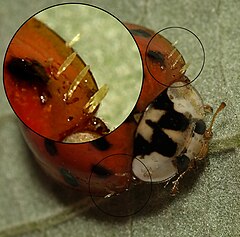Laboulbeniales
Laboulbeniales es un orden de hongos en la clase Laboulbeniomycetes. A veces se les denomina, polizontes de cascarudos.[1] El orden contiene unas 2325 especies[2] de ectoparásitos obligados de insectos que producen talos celulares a partir de ascoesporas de dos células. Recientemente, el género Herpomyces, tradicionalmente considerado un miembros basal de Laboulbeniales, fue transferido al orden Herpomycetales a partir de información recolectada en estudios moleculares filogenéticos.[3][4] Laboulbeniales por lo general no matan a quienes les hospedan, si bien pueden afectar la movilidad de su hospedador si la densidad de parásitos es alta.
| Laboulbeniales | ||
|---|---|---|
 Laboulbeniales en Harmonia axyridis | ||
| Taxonomía | ||
| Reino: | Fungi | |
| División: | Ascomycota | |
| Clase: | Laboulbeniomycetes | |
| Orden: |
Laboulbeniales Engler (1898) | |
| Familias | ||
Estudios filogenéticos moleculares recientes han determinado que algunos taxones son complejos de varias especies segregadas por el hospedador, por ejemplo Hesperomyces virescens.[5] La clasificación del orden Laboulbeniales corresponde a la definida por Isabelle Tavares (1985) aunque varios taxones de dicho sistema son polifiléticos.[6][7]
Referencias
editar- ↑ Cooke MC (1892). «Vegetable wasps and plant worms : a popular history of entomogenous fungi, or fungi parasitic upon insects /». Metcalf Collection (North Carolina State University). (en inglés) (Londres: Society for Promoting Christian Knowledge). doi:10.5962/bhl.title.34922.
- ↑ Kirk, Paul (2019). «Catalogue of Life».
- ↑ Haelewaters, Danny; Pfliegler, Walter P.; Gorczak, Michał; Pfister, Donald H. (2019). «Birth of an order: Comprehensive molecular phylogenetic study excludes Herpomyces (Fungi, Laboulbeniomycetes) from Laboulbeniales». Molecular Phylogenetics and Evolution (en inglés) 133: 286-301. doi:10.1016/j.ympev.2019.01.007.
- ↑ Blackwell, Meredith; Haelewaters, Danny; Pfister, Donald H. (2020). «Laboulbeniomycetes: Evolution, natural history, and Thaxter’s final word». Mycologia (en inglés): 1-12. ISSN 0027-5514. doi:10.1080/00275514.2020.1718442.
- ↑ Haelewaters D, De Kesel A, Pfister DH (2018). «Integrative taxonomy reveals hidden species within a common fungal parasite of ladybirds». Scientific Reports 8 (1): 15966. Bibcode:2018NatSR...815966H. PMC 6206035. PMID 30374135. doi:10.1038/s41598-018-34319-5.
- ↑ Goldmann L, Weir A (2018). «Molecular phylogeny of the Laboulbeniomycetes (Ascomycota)». Fungal Biology 122 (2–3): 87-100. PMID 29458722. doi:10.1016/j.funbio.2017.11.004.
- ↑ Haelewaters D, Page RA, Pfister DH (2018). «Laboulbeniales hyperparasites (Fungi, Ascomycota) of bat flies: Independent origins and host associations». Ecology and Evolution 8 (16): 8396-8418. PMC 6145224. PMID 30250711. doi:10.1002/ece3.4359.
Bibliografía
editar- Alexopolous CJ, Mims CW, Blackwell M (2004). Introductory Mycology (4th edición). Hoboken NJ: John Wiley and Sons. ISBN 0-471-52229-5.
- Thaxter R (1896). «Contribution towards a monograph of the Laboulbeniaceae. I.». Memoirs of the American Academy of Arts and Sciences 12: 187-429.
- Thaxter R (1908). «Contribution towards a monograph of the Laboulbeniaceae. II.». Memoirs of the American Academy of Arts and Sciences 13 (6): 217-469. JSTOR 25058090. doi:10.2307/25058090.
- Thaxter R (1924). «Contribution towards a monograph of the Laboulbeniaceae. III.». Memoirs of the American Academy of Arts and Sciences 14 (5): 309-426. JSTOR 25058114. doi:10.2307/25058114.
- Thaxter R (1926). «Contribution towards a monograph of the Laboulbeniaceae. IV.». Memoirs of the American Academy of Arts and Sciences 15 (4): 427-580. JSTOR 25058132. doi:10.2307/25058132.
- Thaxter R (1931). «Contribution towards a monograph of the Laboulbeniaceae. V.». Memoirs of the American Academy of Arts and Sciences 16: 1-435. JSTOR 25058136. doi:10.2307/25058136.